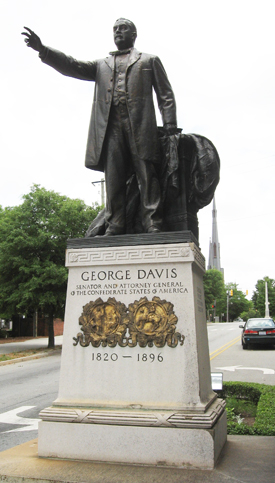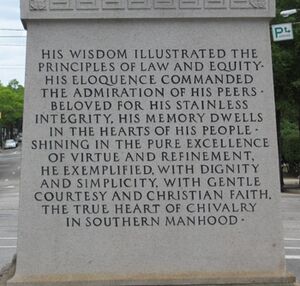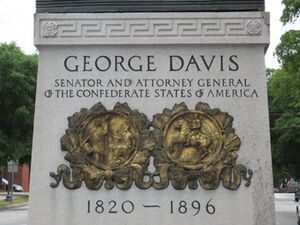George Davis Monument facts for kids
The George Davis Monument was a statue built to honor George Davis. He was a lawyer and a politician for the Confederacy. The monument was located in Wilmington, North Carolina. It was put up by a group called the United Daughters of the Confederacy.
Before the American Civil War, George Davis was a railroad lawyer. He was also a member of the Whig Party, which supported keeping the United States together. After some states decided to leave the U.S. (this is called secession), Davis became a senator and later the attorney general for the Confederacy. He was known for being a good speaker. In March 1861, he publicly said that North Carolina should leave the United States. He believed this would protect the state's economic interest in slavery.
The statue was first shown to the public on April 20, 1911. This was 46 years after the Confederacy lost the war. In the early morning of June 25, 2020, the City of Wilmington took down the statue. They said they did this to keep people safe and protect important historical items.
The city said the removal was only for a short time. This happened around the same time that three city police officers were fired. This was because very racist discussions they had were found on official police recordings. The city government did not say where the statue was stored. They also did not announce when it would be put back up. The stone base (pedestal) of the monument, which had misleading inscriptions, stayed in place. By June 30, the pedestal was covered with a black cloth. This hid the words written on it.
Contents
The George Davis Monument's Story
Why Was the Monument Built?
When people first thought about building this monument, many white leaders in Wilmington remembered Davis as a great speaker. The statue shows Davis with his hand on a podium, as if he is giving a speech.
Davis's 1861 Speech on Slavery
On March 2, 1861, George Davis gave an important speech in Wilmington. He had just returned from a failed peace meeting in Washington. In his speech, Davis announced that he now supported secession. He had once been against it.
He clearly stated that the main reason for North Carolina to leave the United States was to keep slavery. He said:
"The division must be made on the line of slavery. The State must go with the South."
How the Idea for the Monument Began
The idea for the monument came from Chapter 3 of the United Daughters of the Confederacy (UDC) in Cape Fear. They thought of it in 1901. This was three years after white groups used violence to illegally remove a fairly elected biracial government in the Wilmington insurrection of 1898. It was also five years after Davis died and 36 years after the Confederacy lost the Civil War.
Historians say that monuments like this one were part of a bigger effort. Groups like the UDC wanted to spread a false story called the Lost Cause Narrative. This story tried to change how people remembered the Civil War. They also wanted to show non-white people that the period of Reconstruction (when the South was rebuilt after the war) was truly over. These monuments also supported the idea of white supremacy.
It took many years for the UDC to make their idea for the monument a reality.
How the Monument Was Paid For
The UDC Cape Fear Chapter 3 started collecting money in 1904. However, it was slow to raise funds, even though the UDC said it was very important. The chapter's records show that they finished raising money in April 1909. They had collected almost $900.
The rest of the money came from James Sprunt. He was from a wealthy family that made money from cotton. When he was young, Sprunt worked on ships that broke through blockades during the Civil War. He made a lot of money during the war. Sprunt said he gathered his part of the money from friends and co-workers. His contribution brought the total amount raised to $5,010.34. This would be about $144,000 in 2019.
Making the Statue
The statue was created by Francis Herman Packer. He was born in Germany and lived in Long Island, New York. He had studied with a famous sculptor named Augustus Saint-Gaudens.
James Sprunt paid for Packer's travel. Packer's sculpture was cast (shaped from melted metal) by the Gorham Manufacturing Company in Rhode Island in 1910.
The statue is 8 feet tall and made of bronze. It weighs 1,700 pounds. The stone base (pedestal) weighs five and a half tons. It has shiny gold seals of North Carolina and the former Confederate States of America. The pedestal also has long, misleading words praising Davis's supposed good qualities.
About ten years later, the UDC hired Packer again. He sculpted another Confederate memorial one block south. That statue was also taken down in June 2020.
Where the Monument Was Placed
The monument stood on a grassy area in the middle of Market Street. It was just east of where Market Street meets Third Street. This is a very central part of the city. From the monument, you could see Wilmington's city hall, the New Hanover County courthouse, and St. James Episcopal Parish. This church is the city's oldest Christian church.
The statue faced west, towards the end of Market Street at the Cape Fear River. This riverfront area was a marketplace. Enslaved people and their children were sold there from the early 1700s until the city was captured by the Union Army in 1865 during the Civil War.
Putting Up and Dedicating the Monument
The first stone of the monument (the cornerstone) was placed on October 14, 1909. This was done during a ceremony by a group called the Masons. Inside the cornerstone, they put:
- A copy of a church newspaper from October 1909
- A copy of the official paper that made George Davis the Attorney General of the Confederate states, dated January 4, 1864
- Some coins
The monument was officially dedicated on April 20, 1911. Four of Davis's grandsons helped with the ceremony: M.F.H. Gouverneur Jr., Donald McRae Jr., George Rountree, and Robert Cowan Davis.
U.S. District Court Judge Henry G. Connor gave the main speech. The Delgado Band was paid $25 to play music.
Many historians say that Judge Connor's speech showed signs of the "Lost Cause mythology." He wrongly described Davis's actions against the United States as "patriotism." He also called Davis's call for secession "moderation in speech." Connor said:
“You shall bring your sons to this spot, tell them the story of his life, of his patriotism of his loyalty to high thinking and noble living, of his moderation in speech, his patience under defeat, of his devotion to your City and State as a perpetual illustration and an enduring example of the dignity, the worth of a high-souled, pure-hearted Christian gentleman.”
Changes and Damage Over Time
1993
The "George Davis Camp 5" of the Sons of Confederate Veterans celebrated George Davis's birthday at the monument.
1995
Davis's family members held a ceremony at the monument.
2000
In October, a truck from Hanover Iron Works accidentally hit the statue. This knocked it off its base. The statue got a dent on the back of its head and cracks on its neck and right shoulder. Repairs, which included reshaping the base, cost $25,000. They took more than a year to finish.
The monument was put back up in February 2002. It was placed 6 feet from its original spot and raised on a new 6-inch curb.
2019
On June 29, a peaceful group gathered at the monument. They asked the city to move it to a museum.
In the early morning of July 4, someone threw orange paint on the monument.
2020 Removal and Covering
In June 2020, the City of Wilmington took down the statue. They said this was to "protect the public safety and to preserve important historical artifacts." The stone base was left behind. Later, the base was covered with a black cloth, hiding its inscriptions.
In September, Wilmington's mayor said that the danger to public safety that led to the monument's removal was still present. Most members of the Wilmington City Council told a reporter that deciding what to do with the city's Confederate monuments was not a top priority for them.
Gallery












